#chamaeleon cloud complex
Explore tagged Tumblr posts
Photo
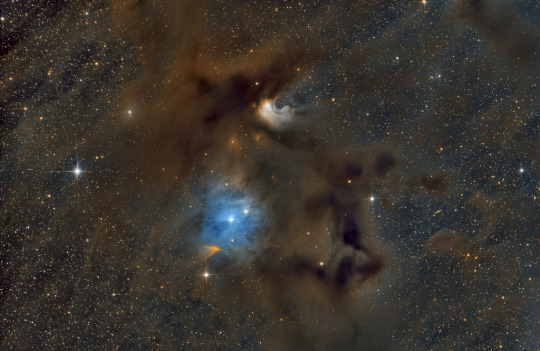
2024 May 27
Chamaeleon I Molecular Cloud Image Credit & Copyright: Amiel Contuliano
Explanation: Dark markings and bright nebulae in this telescopic southern sky view are telltale signs of young stars and active star formation. They lie a mere 650 light-years away, at the boundary of the local bubble and the Chamaeleon molecular cloud complex. Regions with young stars identified as dusty reflection nebulae from the 1946 Cederblad catalog include the C-shaped Ced 110 just above and right of center, and bluish Ced 111 below it. Also a standout in the frame, the orange tinted V-shape of the Chamaeleon Infrared Nebula (Cha IRN) was carved by material streaming from a newly formed low-mass star. The well-composed image spans 1.5 degrees. That's about 17 light-years at the estimated distance of the nearby Chamaeleon I molecular cloud.
∞ Source: apod.nasa.gov/apod/ap240527.html
64 notes
·
View notes
Text
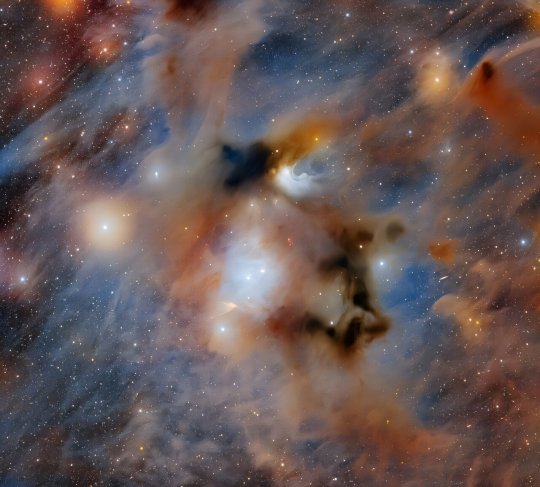
Dark energy camera captures sparse pockets of light among dark clouds of Chamaeleon I
The origin of our sun, and all the planets, comets and asteroids that orbit it, can be traced back to their birthplace inside a massive cloud of cold gas and dust, not unlike the billowing molecular cloud featured in this image. Found within these cool regions of highly condensed interstellar material are stellar nurseries where young stars are emerging from the swirling gaseous plumes. These regions are also home to nebulae that shine bright with the reflected light of newly formed stars.
This image was captured with the 570-megapixel Department of Energy-fabricated Dark Energy Camera (DECam) mounted on the U.S. National Science Foundation Víctor M. Blanco 4-meter Telescope at Cerro Tololo Inter-American Observatory. It showcases the atramentous molecular cloud known as the Chamaeleon I dark cloud. Located about 500 light-years away, Chamaeleon I is the nearest active star-forming region to Earth. This dark cloud is estimated to be around two billion years old and is home to about 200–300 stars.
Chamaeleon I is just a small component of the larger Chamaeleon Complex, an enormous active stellar birthplace that occupies almost the entirety of the southern constellation Chamaeleon, even overlapping into Apus, Musca, Carina and Octans. The Chamaeleon Complex also includes the Chamaeleon II and Chamaeleon III dark clouds, which show little and no active star formation, respectively.
Near the center of the image, brightly glowing from within the thick cosmic dust, is one of Chamaeleon I's notable features, the stunning reflection nebula Cederblad 111. Reflection nebulae are clouds of gas and dust that do not create their own light, but instead shine by reflecting the light from nearby stars. This happens in the surroundings of newly formed stars that are not hot enough to excite the hydrogen atoms of the cloud, as is the case for emission nebulae. Instead, their light bounces off of the particles within the cloud.
Cederblad 110, a second reflection nebula within Chamaeleon I, can be seen just above Cederblad 111 with its recognizable C-shape. Like Cederblad 111, Cederblad 110 lies close to an active low-mass star-forming region where the light of young stars is scattered by the nebula's dust particles. This reflection creates a bright pocket of light among the otherwise opaque clouds.
Below the pair of reflection nebulae is the orange-tinted Chamaeleon Infrared Nebula. Resembling the wings of an ethereal cosmic aviator, this nebula is the product of streams of fast-moving gas that are being ejected from a newly formed low-mass star at the core of the nebula. These streams have carved a tunnel through the interstellar cloud where the young star was born. The infrared and visible light emitted by the nascent star escapes along this tunnel and scatters off its walls, giving rise to the wispy reflection nebula.
Embedded throughout Chamaeleon I, astronomers have also found numerous Herbig-Haro objects—bright patches of nebulosity that form when ionized jets of gas ejected from newly born stars collide with slow-moving gas in the surrounding cloud. One of these objects can be spotted as a tiny, faint red patch lying in the dusty realm between Cederblad 111 and Cederblad 110.
IMAGE: The Ominous Chamaeleon I dark cloud. Credit: CTIO / NOIRLab / DOE / NSF / AURA; Image Processing: T.A. Rector (University of Alaska Anchorage / NSF NOIRLab), M. Zamani & D. de Martin (NSF NOIRLab)
youtube
Pan on the Chamaeleon I dark cloud. Credit: CTIO / NOIRLab / DOE / NSF / AURA; Image Processing: T.A. Rector (University of Alaska Anchorage / NSF NOIRLab), M. Zamani & D. de Martin (NSF NOIRLab)
youtube
Zooming into the Chamaeleon I dark cloud. Credit: CTIO / NOIRLab / DOE / NSF / AURA; Image Processing: T.A. Rector (University of Alaska Anchorage / NSF NOIRLab), M. Zamani & D. de Martin (NSF NOIRLab)
5 notes
·
View notes
Photo

Chamaeleon I Molecular Cloud, 2024-05-27
Dark markings and bright nebulae in this telescopic southern sky view are telltale signs of young stars and active star formation. They lie a mere 650 light-years away, at the boundary of the local bubble and the Chamaeleon molecular cloud complex. Regions with young stars identified as dusty reflection nebulae from the 1946 Cederblad catalog include the C-shaped Ced 110 just above and right of center, and bluish Ced 111 below it. Also a standout in the frame, the orange tinted V-shape of the Chamaeleon Infrared Nebula (Cha IRN) was carved by material streaming from a newly formed low-mass star. The well-composed image spans 1.5 degrees. That's about 17 light-years at the estimated distance of the nearby Chamaeleon I molecular cloud.
Credits: NASA's 'Astronomy Picture Of The Day.'
9 notes
·
View notes
Text
Star-forming cloud Chamaeleon I looks like a cosmic masterpiece in new Dark Energy Camera image (video)
The universe is full of cosmic masterpieces, none more so than this stunningly evocative vista of the Chamaeleon I dark cloud.Chamaeleon I is part of the closest star-forming complex to us, the Chamaeleon Complex, and is depicted here with inky black dabs of interstellar dust mixed with the brushstrokes of bright reflection nebulae illuminated by young stars.Located about 500 light years away,
Read More: You won't believe what happens next... Click here!
0 notes
Text

Chamaeleon I Molecular Cloud
Explanation: Dark markings and bright nebulae in this telescopic southern sky view are telltale signs of young stars and activestar formation. They lie a mere 650 light-years away, at the boundary of the local bubble and the Chamaeleon molecular cloud complex. Regions with young stars identified as dusty reflection nebulae from the 1946 Cederblad catalog include the C-shaped Ced 110 just above and right of center, and bluish Ced 111 below it. Also a standout in the frame, the orange tinted V-shape of the Chamaeleon Infrared Nebula (Cha IRN) was carved by material streaming from a newly formed low-mass star. The well-composed image spans 1.5 degrees. That's about 17 light-years at the estimated distance of the nearby Chamaeleon I molecular cloud.
0 notes
Text
Groundbreaking Survey Reveals Secrets of Planet Birth Around Dozens of Stars - Technology Org
New Post has been published on https://thedigitalinsider.com/groundbreaking-survey-reveals-secrets-of-planet-birth-around-dozens-of-stars-technology-org/
Groundbreaking Survey Reveals Secrets of Planet Birth Around Dozens of Stars - Technology Org
In a series of studies, a team of astronomers led by Per-Gunnar Valegård has shed new light on the fascinating and complex process of planet formation.
One of the studies were led by Per-Gunnar Valegård, a doctoral student at the University of Amsterdam. The stunning images, captured using the European Southern Observatory’s Very Large Telescope (ESO’s VLT) in Chile, represent one of the largest ever surveys of planet-forming discs.
The research brings together observations of more than 80 young stars that might have planets forming around them, providing astronomers with a wealth of data and unique insights into how planets arise in different regions of our galaxy.
Planet-forming discs. Image credit: ESO/C. Ginski, A. Garufi, P.-G. Valegård et al.
“This is really a shift in our field of study,” says Christian Ginski, who was formerly a postdoc at the University of Amsterdam, currently a lecturer at the University of Galway, Ireland, and lead author of one of three new papers published in Astronomy & Astrophysics. “We’ve gone from the intense study of individual star systems to this huge overview of entire star-forming regions.”
To date more than 5000 planets have been discovered orbiting stars other than the Sun, often within systems markedly different from our own Solar System. To understand where and how this diversity arises, astronomers must observe the dust- and gas-rich discs that envelop young stars — the very cradles of planet formation. These are best found in huge gas clouds where the stars themselves are forming.
Much like mature planetary systems, the new images showcase the extraordinary diversity of planet-forming discs. “Some of these discs show huge spiral arms, presumably driven by the intricate ballet of orbiting planets,” says Ginski. “Others show rings and large cavities carved out by forming planets, while yet others seem smooth and almost dormant among all this bustle of activity,” adds Antonio Garufi, an astronomer at the Arcetri Astrophysical Observatory, Italian National Institute for Astrophysics (INAF), and lead author of one of the papers.
The team studied a total of 86 stars across three different star-forming regions of our galaxy: Taurus and Chamaeleon I, both around 600 light-years from Earth, and Orion, a gas-rich cloud about 1600 light-years from us that is known to be the birthplace of several stars more massive than the Sun. The observations were gathered by a large international team, comprising scientists from more than 10 countries.
The team was able to glean several key insights from the dataset. For example, in Orion they found that stars in groups of two or more were less likely to have large planet-forming discs. This is a significant result given that, unlike our Sun, most stars in our galaxy have companions. As well as this, the uneven appearance of the discs in this region suggests the possibility of massive planets embedded within them, which could be causing the discs to warp and become misaligned.
While planet-forming discs can extend for distances hundreds of times greater than the distance between Earth and the Sun, their location several hundreds of light-years from us makes them appear as tiny pinpricks in the night sky. To observe the discs, the team employed the sophisticated Spectro-Polarimetric High-contrast Exoplanet REsearch instrument (SPHERE) mounted on ESO’s VLT.
SPHERE’s state-of-the-art extreme adaptive optics system corrects for the turbulent effects of Earth’s atmosphere, yielding crisp images of the discs. This meant the team were able to image discs around stars with masses as low as half the mass of the Sun, which are typically too faint for most other instruments available today.
Additional data for the survey were obtained using the VLT’s X-shooter instrument, which allowed astronomers to determine how young and how massive the stars are. The Atacama Large Millimeter/submillimeter Array (ALMA), in which ESO is a partner, on the other hand, helped the team understand more about the amount of dust surrounding some of the stars.
As technology advances, the team hopes to delve even deeper into the heart of planet-forming systems. The large 39-metre mirror of ESO’s forthcoming Extremely Large Telescope (ELT), for example, will enable the team to study the innermost regions around young stars, where rocky planets like our own might be forming.
For now, these spectacular images provide researchers with a treasure trove of data to help unpick the mysteries of planet formation. “It is almost poetic that the processes that mark the start of the journey towards forming planets and ultimately life in our own Solar System should be so beautiful,” concludes Per-Gunnar Valegård, a doctoral student at the University of Amsterdam, the Netherlands, who led the Orion study. Valegård, who is also a part-time teacher at the International School Hilversum in the Netherlands, hopes the images will inspire his pupils to become scientists in the future.
Source: University of Amsterdam
You can offer your link to a page which is relevant to the topic of this post.
#ALMA#amp#Art#Astronomy#Astronomy news#Astrophysics#atmosphere#Cloud#clouds#data#diversity#dust#earth#Earth’s atmosphere#effects#elt#employed#European Southern Observatory#exoplanet#Featured Space news#formation of planets#Fundamental physics news#Future#Galaxy#gas#hand#heart#how#images#insights
0 notes
Text
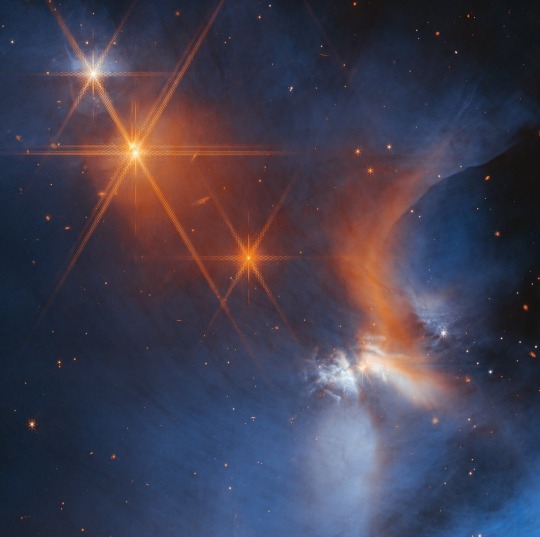
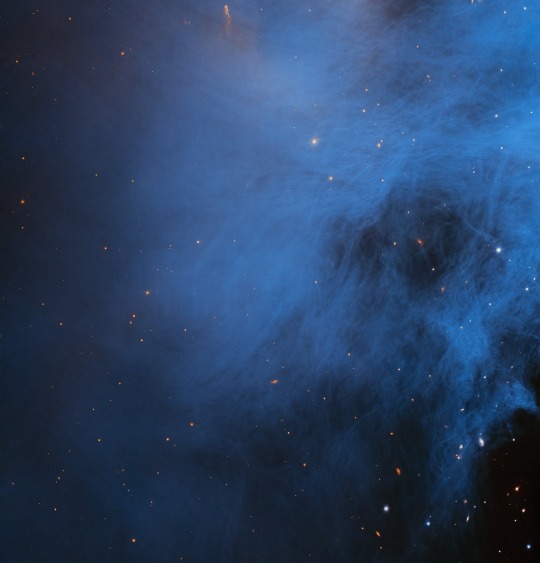
Webb Unveils Dark Side
An international team of astronomers using NASA’s James Webb Space Telescope has obtained an in-depth inventory of the deepest, coldest ices measured to date in a molecular cloud. In addition to simple ices like water, the team was able to identify frozen forms of a wide range of molecules, from carbonyl sulfide, ammonia, and methane, to the simplest complex organic molecule, methanol. This is the most comprehensive census to date of the icy ingredients available to make future generations of stars and planets, before they are heated during the formation of young stars.
This image from the telescope’s Near-Infrared Camera (NIRCam) features the central region of the Chamaeleon I dark molecular cloud, which resides 630 light-years away. The cold, wispy cloud material (blue, center) is illuminated in the infrared by the glow of the young, outflowing protostar Ced 110 IRS 4 (orange, upper). The light from numerous background stars, seen as orange dots behind the cloud, can be used to detect ices in the cloud, which absorb the starlight passing through them.
Image credit: NASA, ESA, CSA, and M. Zamani
#jwst#jameswebb#astrophyscs#astrofisica#astronomia#astronomy#space#espaço#stars#universe#nebulosa#nebula#dust#gas
1K notes
·
View notes
Photo

Chamaeleon I Molecular Cloud : Dark markings and bright nebulae in this telescopic southern sky view are telltale signs of young stars and active star formation. They lie a mere 650 light-years away, at the boundary of the local bubble and the Chamaeleon molecular cloud complex. Regions with young stars identified as dusty reflection nebulae from the 1946 Cederblad catalog include the C-shaped Ced 110 just above and left of center, and bluish Ced 111 below it. Also a standout in the frame, the orange tinted V-shape of the Chamaeleon Infrared Nebula (Cha IRN) was carved by material streaming from a newly formed low-mass star. The well-composed image spans 1.5 degrees. That's about 17 light-years at the estimated distance of the nearby Chamaeleon I molecular cloud. via NASA
802 notes
·
View notes
Photo

Chamaeleon II Dark Cloud Image Credit & Copyright: Don Goldman Explanation: A small constellation hiding near the south celestial pole, The Chamaeleon boasts no bright stars. Stars are forming within its constellation boundaries though, in a complex of dark, dusty molecular clouds. Some 500 light-years distant, the Chamaeleon II dark nebula inhabits this view where the cosmic dust clouds standout mostly in silhouette against the starry southern sky. The telescopic frame is about the angular size of a Full Moon and so spans about 5 light-years at the dark cloud's estimated distance. Scattered near center a telltale reddish glow from identified Herbig-Haro objects is seen in the sharp image, jets of shocked glowing gas emanating from recently formed stars. NASA APOD (https://ift.tt/319ePEh) via Instagram https://ift.tt/2MDbHwr
25 notes
·
View notes
Photo

Chamaeleon II Dark Cloud A small constellation hiding near the south celestial pole, The Chamaeleon boasts no bright stars. Stars are forming within its constellation boundaries though, in a complex of dark, dusty molecular clouds. Some 500 light-years distant, the Chamaeleon II dark nebula inhabits this view where the cosmic dust clouds standout mostly in silhouette against the starry southern sky. The telescopic frame is about the angular size of a Full Moon and so spans about 5 light-years at the dark cloud's estimated distance. Scattered near center a telltale reddish glow from identified Herbig-Haro objects is seen in the sharp image, jets of shocked glowing gas emanating from recently formed stars. August 02, 2019 via Space https://ift.tt/319ePEh
2 notes
·
View notes
Photo
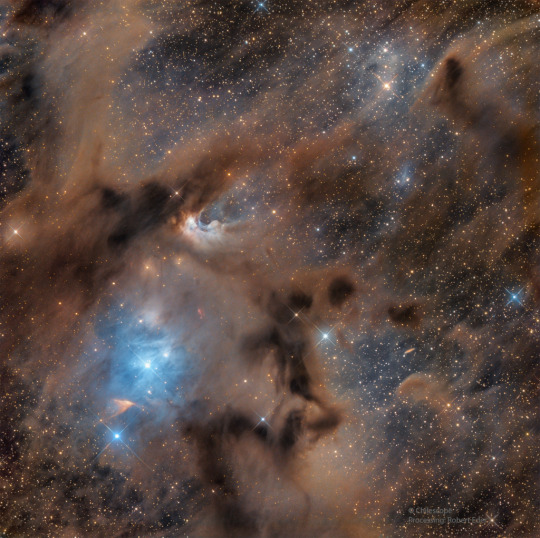
2022 February 17
Chamaeleon I Molecular Cloud Image Credit & Copyright: Acquisition: Stas Volskiy (Chilescope.com), Processing: Robert Eder
Explanation: Dark markings and bright nebulae in this telescopic southern sky view are telltale signs of young stars and active star formation. They lie a mere 650 light-years away, at the boundary of the local bubble and the Chamaeleon molecular cloud complex. Regions with young stars identified as dusty reflection nebulae from the 1946 Cederblad catalog include the C-shaped Ced 110 just above and left of center, and bluish Ced 111 below it. Also a standout in the frame, the orange tinted V-shape of the Chamaeleon Infrared Nebula (Cha IRN) was carved by material streaming from a newly formed low-mass star. The well-composed image spans 1.5 degrees. That's about 17 light-years at the estimated distance of the nearby Chamaeleon I molecular cloud.
∞ Source: apod.nasa.gov/apod/ap220217.html
33 notes
·
View notes
Text

Webb unmasks true nature of the 'Cosmic Tornado' spiral galaxy
The NASA/ESA/CSA James Webb Space Telescope has captured a beautiful juxtaposition of the nearby protostellar outflow known as Herbig-Haro 49/50 with a perfectly positioned, more distant spiral galaxy. Due to the close proximity of this Herbig-Haro object to Earth, this new composite infrared image of the outflow from a young star allows researchers to examine details on small spatial scales like never before. With Webb, we can better understand how the jet activity associated with the formation of young stars can affect their surrounding environment.
This new composite image combines observations from Webb's NIRCam (Near-Infrared Camera) and MIRI (Mid-Infrared Instrument), which provides a high-resolution view to explore the exquisite details of this bubbling activity. Herbig-Haro 49/50 is located about 630 light-years from Earth in the constellation Chamaeleon.
Herbig-Haro objects are outflows produced by jets launched from a nearby, forming star. The outflows, which can extend for light-years, plow into a denser region of material. This creates shock waves, heating the material to higher temperatures. The material then cools by emitting light at visible and infrared wavelengths.
When NASA's Spitzer Space Telescope observed it in 2006, scientists nicknamed Herbig-Haro 49/50 (HH 49/50) the "Cosmic Tornado" for its helical appearance, but they were uncertain about the nature of the fuzzy object at the tip of the "tornado."
With its higher imaging resolution, Webb provides a different visual impression of HH 49/50 by revealing fine features of the shocked regions in the outflow, uncovering the fuzzy object to be a distant spiral galaxy, and displaying a sea of distant background galaxies.
HH 49/50 is located in the Chamaeleon I Cloud complex, one of the nearest active star formation regions in our Milky Way, which is creating numerous low-mass stars similar to our sun. This cloud complex is likely similar to the environment that our sun formed in. Past observations of this region show that the HH 49/50 outflow is moving away from us at speeds of 100–300 kilometers per second and is just one feature of a larger outflow.
Webb's NIRCam and MIRI observations of HH 49/50 trace the location of glowing hydrogen molecules, carbon monoxide molecules, and energized grains of dust, represented in orange and red, as the protostellar jet slams into the region. Webb's observations probe details on small spatial scales that will help astronomers to model the properties of the jet and understand how it is affecting the surrounding material.
The arc-shaped features in HH 49/50, similar to a water wake created by a speeding boat, point back to the source of this outflow. Based on past observations, scientists suspect that a protostar known as Cederblad 110 IRS4 is a plausible driver of the jet activity.
Located roughly 1.5 light-years away from HH 49/50 (off the lower right corner of the Webb image), CED 110 IRS4 is a Class I protostar. Class I protostars are young objects (tens of thousands to a million years old) in the prime time of gaining mass. They usually have a discernible disk of material surrounding them that is still falling onto the protostar. Scientists recently used Webb's NIRCam and MIRI observations to study this protostar and obtain an inventory of the icy composition of its environment.
These detailed Webb images of the arcs in HH 49/50 can more precisely pinpoint the direction of the jet source, but not every arc points back in the same direction. For example, there is an interesting outcrop feature (at the top right of the main outflow) which could be another chance superposition of a different outflow, related to the slow precession of the intermittent jet source. Alternatively, this feature could be a result of the main outflow breaking apart.
The galaxy that appears by happenstance at the tip of HH 49/50 is a much more distant, face-on spiral galaxy. It has a prominent central bulge represented in blue that shows the location of older stars. The bulge also shows hints of "side lobes," suggesting that this could be a barred-spiral galaxy. Reddish clumps within the spiral arms show the locations of warm dust and groups of forming stars. The galaxy even displays evacuated bubbles in these dusty regions, similar to nearby galaxies observed by Webb as part of the PHANGS program.
Webb has captured these two unassociated objects in a lucky alignment. Over thousands of years, the edge of HH 49/50 will move outwards and eventually appear to cover up the distant galaxy.
IMAGE: Angled from the upper left corner to the lower right corner of the image is a conical shaped orange-red cloud known at Herbig-Haro 49/50. This feature takes up about three-fourths of the length of this angle. The upper left end of this feature has a translucent, rounded end. At this same location there is a background spiral shaped galaxy with a concentrated blue center that fades outwards to blend in with red spiral arms. The conical feature widens slightly from the rounded end at the upper right down to the lower right. The black background of space is clearer, speckled with some white stars and smaller, more numerous, fainter white galaxies. Credit: NASA, ESA, CSA, STScI
youtube
youtube
3 notes
·
View notes
Text
ESO: Hidden views of vast stellar nurseries
A new report from the European Space Observatory (ESO): ESO telescope reveals hidden views of vast stellar nurseries
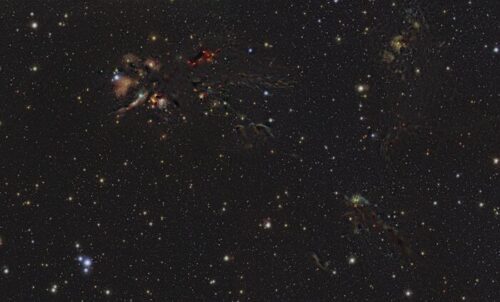
This image shows the L1688 region in the Ophiuchus constellation. New stars are born in the colourful clouds of gas and dust seen here. The infrared observations underlying this image reveal new details in the star-forming regions that are usually obscured by the clouds of dust. The image was produced with data collected by the VIRCAM instrument, which is attached to the VISTA telescope at ESO’s Paranal Observatory in Chile. The observations were done as part of the VISIONS survey, which will allow astronomers to better understand how stars form in these dust-enshrouded regions. This 520-million-pixel image can be explored in more detail with this zoomable version. Using ESO’s Visible and Infrared Survey Telescope for Astronomy (VISTA), astronomers have created a vast infrared atlas of five nearby stellar nurseries by piecing together more than one million images. These large mosaics reveal young stars in the making, embedded in thick clouds of dust. Thanks to these observations, astronomers have a unique tool with which to decipher the complex puzzle of stellar birth. “In these images we can detect even the faintest sources of light, like stars far less massive than the Sun, revealing objects that no one has ever seen before,” says Stefan Meingast, an astronomer at the University of Vienna in Austria and lead author of the new study published today in Astronomy & Astrophysics. “This will allow us to understand the processes that transform gas and dust into stars.” Stars form when clouds of gas and dust collapse under their own gravity, but the details of how this happens are not fully understood. How many stars are born out of a cloud? How massive are they? How many stars will also have planets? https://youtu.be/0cCMSOELuRA To answer these questions, Meingast’s team surveyed five nearby star-forming regions with the VISTA telescope at ESO’s Paranal Observatory in Chile. Using VISTA’s infrared camera VIRCAM, the team captured light coming from deep inside the clouds of dust. “The dust obscures these young stars from our view, making them virtually invisible to our eyes. Only at infrared wavelengths can we look deep into these clouds, studying the stars in the making,” explains Alena Rottensteiner, a PhD student also at the University of Vienna and co-author of the study.
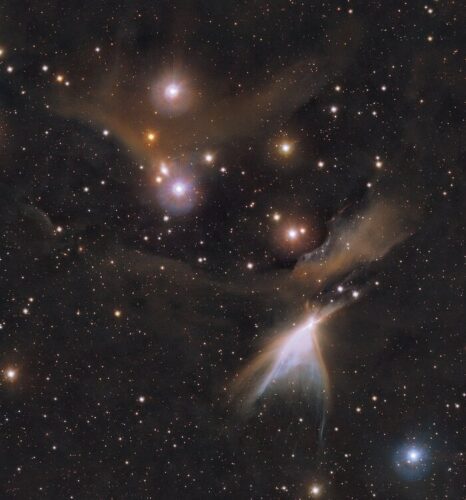
This image shows the HH 909 A object in the Chamaeleon constellation. New stars are born in the colourful clouds of gas and dust seen here. The infrared observations underlying this image reveal new details in the star-forming regions that are usually obscured by the clouds of dust. The image was produced with data collected by the VIRCAM instrument, which is attached to the VISTA telescope at ESO’s Paranal Observatory in Chile. The observations were done as part of the VISIONS survey, which will allow astronomers to better understand how stars form in these dust-enshrouded regions. The survey, called VISIONS, observed star-forming regions in the constellations of Orion, Ophiuchus, Chamaeleon, Corona Australis and Lupus. These regions are less than 1500 light-years away and so large that they span a huge area in the sky. The diameter of VIRCAM’s field of view is as wide as three full Moons, which makes it uniquely suited to map these immensely big regions.
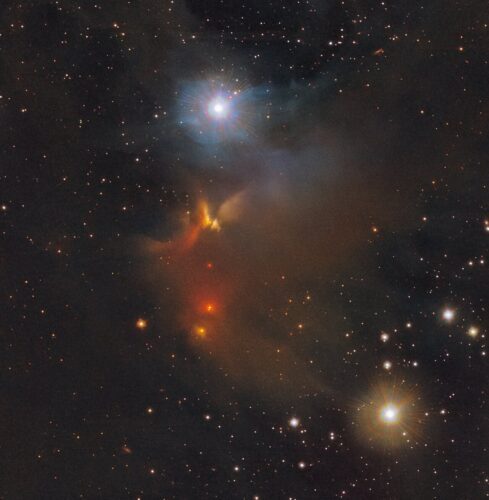
This image shows the IRAS 11051-7706 object in the Chamaeleon constellation. New stars are born in the colourful clouds of gas and dust seen here. The infrared observations underlying the image reveal new details in the star-forming regions that are usually obscured by the clouds of dust. The image was produced with data collected by the VIRCAM instrument, which is attached to the VISTA telescope at ESO’s Paranal Observatory in Chile. The observations were done as part of the VISIONS survey, which will allow astronomers to better understand how stars form in these dust-enshrouded regions. The team obtained more than one million images over a period of five years. The individual images were then pieced together into the large mosaics released here, revealing vast cosmic landscapes. These detailed panoramas feature dark patches of dust, glowing clouds, newly-born stars and the distant background stars of the Milky Way. Since the same areas were observed repeatedly, the VISIONS data will also allow astronomers to study how young stars move. “With VISIONS we monitor these baby stars over several years, allowing us to measure their motion and learn how they leave their parent clouds,” explains João Alves, an astronomer at the University of Vienna and Principal Investigator of VISIONS. This is not an easy feat, as the apparent shift of these stars as seen from Earth is as small as the width of a human hair seen from 10 kilometres away. These measurements of stellar motions complement those obtained by the European Space Agency’s Gaia mission at visible wavelengths, where young stars are hidden by thick veils of dust.
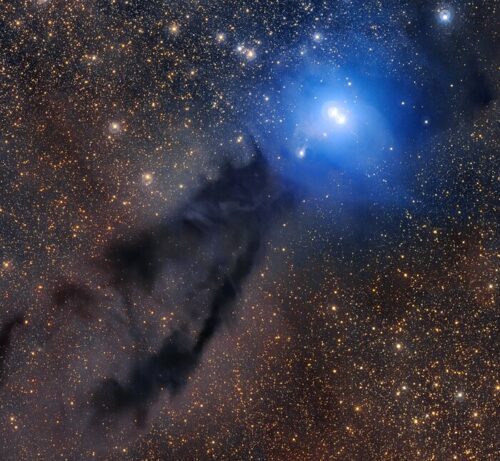
A dark cloud of cosmic dust snakes across this spectacular image, illuminated by the brilliant light of new stars. This dense cloud is a star-forming region called Lupus 3, where dazzlingly hot stars are born from collapsing masses of gas and dust. This image was created from images taken using the VLT Survey Telescope and the MPG/ESO 2.2-metre telescope. Click here for a wider version of this image. The VISIONS atlas will keep astronomers busy for years to come. “There is tremendous long-lasting value for the astronomical community here, which is why ESO steers Public Surveys like VISIONS,” says Monika Petr-Gotzens, an astronomer at ESO in Garching, Germany, and co-author of this study. Moreover, VISIONS will set the groundwork for future observations with other telescopes such as ESO’s Extremely Large Telescope (ELT), currently under construction in Chile and set to start operating later this decade. “The ELT will allow us to zoom into specific regions with unprecedented detail, giving us a never-seen-before close-up view of individual stars that are currently forming there,” concludes Meingast. Links Research paper Photos of VISTA For journalists: subscribe to receive our releases under embargo in your language For scientists: got a story? Pitch your research === Amazon Ads === Orion Skyline 6" Dobsonian Reflector Telescope Kit === Celestron 70mm Travel Scope Portable Refractor Telescope Fully-Coated Glass Optics Ideal Telescope for Beginners BONUS Astronomy Software Package Read the full article
0 notes
Photo
This NASA Hubble Space Telescope image captures one of three segments that comprise a 65-light-year wide star-forming region named the Chamaeleon Cloud Complex. The segment in this Hubble composite image, called Chamaeleon Cloud I (Cha I), reveals dusty-dark clouds where stars are forming, dazzling reflection nebulae glowing by the light of bright-blue young stars, and radiant knots called Herbig-Haro objects.

Hubble Examines a Star-Forming Chamaeleon by NASA’s Marshall Space Flight Center
1K notes
·
View notes
Text
JWST has seen building blocks of life in a dark, cold cloud in space
https://sciencespies.com/space/jwst-has-seen-building-blocks-of-life-in-a-dark-cold-cloud-in-space/
JWST has seen building blocks of life in a dark, cold cloud in space
The James Webb Space Telescope has observed a frigid cloud of dust and gas where stars are forming, and it found frozen elements that are crucial for the development of life
Space 23 January 2023
By Leah Crane
In the central region of the Chamaeleon I cloud, light from background stars (orange) reveals elements in the cold, wispy cloud (blue) of dust and gas
NASA, ESA, CSA, and M. McClure (Leiden)
The James Webb Space Telescope (JWST) has peered into a frigid cloud of dust and gas, looking for the elements that will eventually be incorporated into new planets. The chemistry in molecular clouds like this one is crucial for creating the building blocks of life.
The Chamaeleon I cloud, pictured in the new JWST image, is a star-forming region around 500 light years away. Researchers investigated one of the coldest, darkest regions of the cloud, a dense clump where stars are beginning to form.
The team used what little light passed through this region to identify the ices present there – as starlight filtered through the ice, the atoms and molecules of the cloud absorbed certain wavelengths of light in unique “fingerprints”. These fingerprints allowed the researchers to identify simple ices such as water, carbon dioxide and ammonia, but also more complicated ones including methanol and other organic molecules.
Advertisement
“Our results provide insights into the initial, dark chemistry stage of the formation of ice on the interstellar dust grains that will grow into the centimeter-sized pebbles from which planets form in disks,” said Melissa McClure at Leiden Observatory in the Netherlands in a statement. “This [line of study] will tell us which mixture of ices — and therefore which elements — can eventually be delivered to the surfaces of terrestrial exoplanets or incorporated into the atmospheres of giant gas or ice planets.”
These elements are crucial to the development of life, so understanding how much of each of them is incorporated into a newborn planet can help us determine how habitable that world will end up being. The fact that Chamaeleon I contains complex elements indicates that planets might be born with some of the building blocks of life already baked in.
Sign up to our free Launchpad newsletter for a voyage across the galaxy and beyond, every Friday
More on these topics:
#Space
0 notes
Text
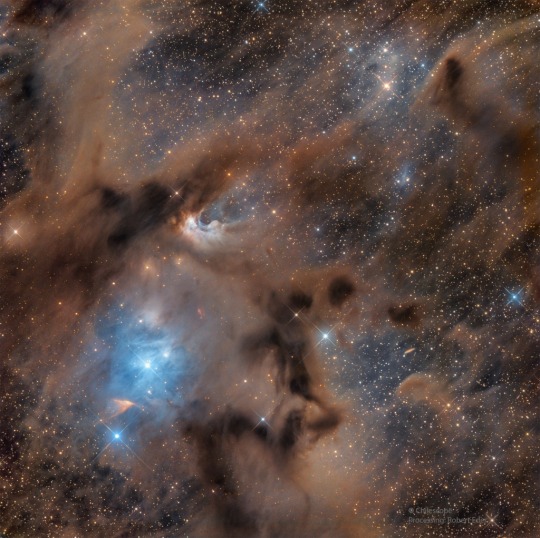
APOD: Chamaeleon I Molecular Cloud (2/17/22) Dark markings and bright nebulae in this telescopic southern sky view are telltale signs of young stars and active star formation. They lie a mere 650 light-years away, at the boundary of the local bubble and the Chamaeleon molecular cloud complex. Regions with young stars identified as dusty reflection nebulae from the 1946 Cederblad catalog include the C-shaped Ced 110 just above and left of center, and bluish Ced 111 below it. Also a standout in the frame, the orange tinted V-shape of the Chamaeleon Infrared Nebula (Cha IRN) was carved by material streaming from a newly formed low-mass star. The well-composed image spans 1.5 degrees. That's about 17 light-years at the estimated distance of the nearby Chamaeleon I molecular cloud. © Robert Eder
0 notes